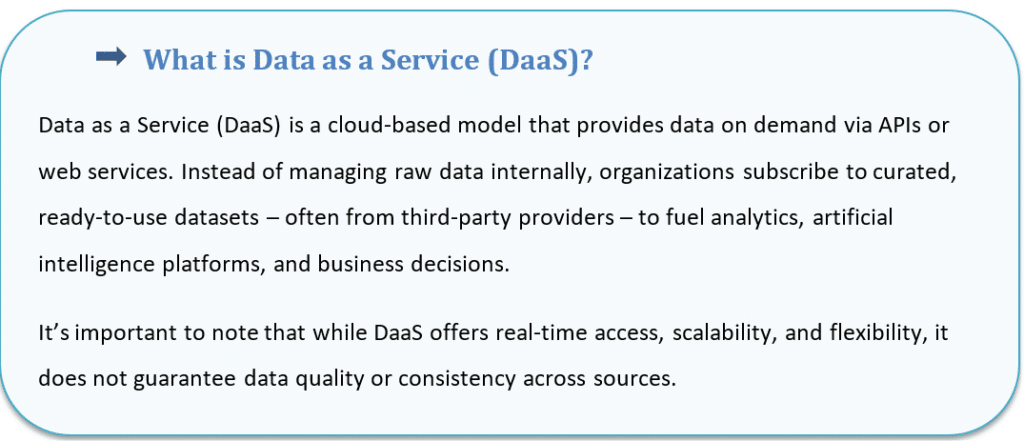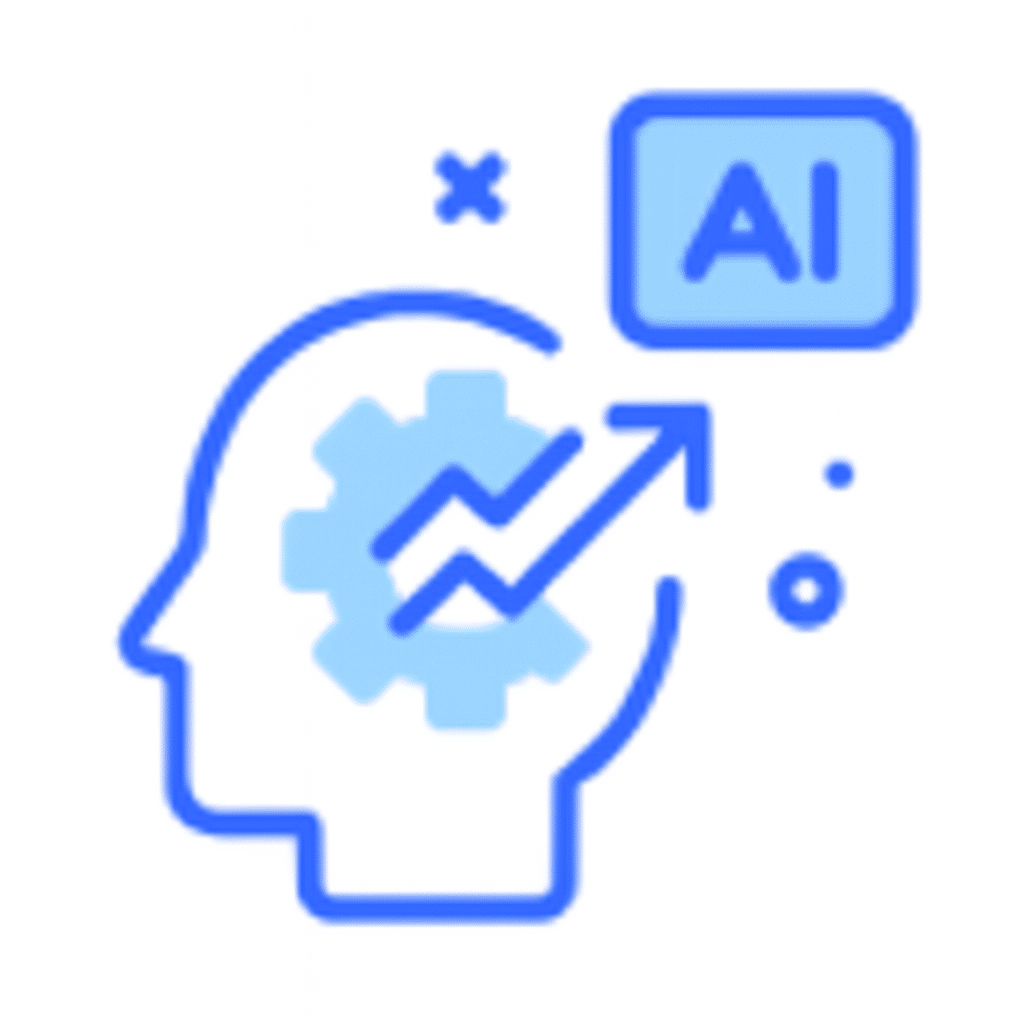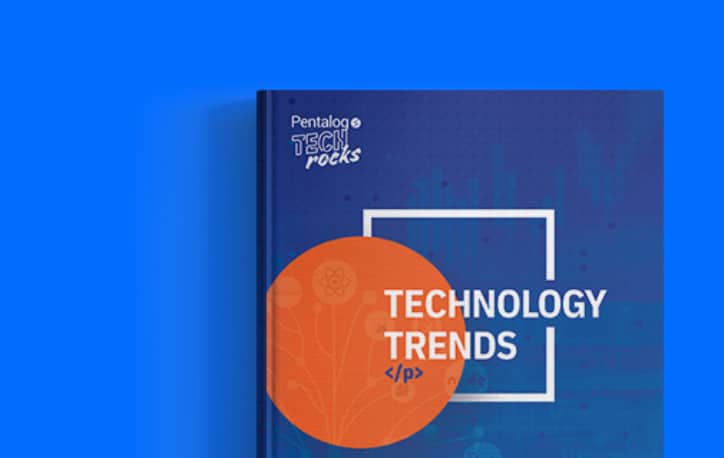Last Updated on November 26, 2025
Everyone’s Talking About DaaS, Few Are Ready for It
The concept of Data as a Service (DaaS) is having its moment. On paper, it’s easy to see why.
Plug into a pipeline, subscribe to curated datasets, and access real-time insights without the operational overhead of managing infrastructure or wrangling raw files. For data professionals trying to unify fragmented internal systems (data silos) with third-party feeds, DaaS looks like a shortcut to speed and scale.
But here’s what most of the glossy diagrams and product decks leave out: data doesn’t clean or reconcile itself just because you pipe it in.
DaaS doesn’t solve identity resolution. It doesn’t deduplicate. It doesn’t tell you whether the “John Smith” from vendor dataset A is the same person as “Jonathan S.” in your CRM or a new record.
That’s still on you.
And unless you’ve already built a strong data matching and quality layer into your stack, the high-speed pipeline you’re building (or have just built) will deliver more noise than insight – costing time, eroding trust, and impacting decision-making accuracy. It will feed flawed insights into everything from dashboards to predictive analytics models.
The real unlock behind DaaS isn’t access – it’s accuracy. And that starts with getting matching right.

Why DaaS Is Everywhere All of a Sudden
It’s no coincidence that DaaS is showing up in more architecture decks, vendor roadmaps, and CDOs’ and data scientists’ meetings.
As cloud data platforms matured, data lakes became less about data storage and more about composability. Businesses no longer want to centralize every dataset. They want to access, query, and activate data wherever it lives. DaaS fits that need. It treats data as a product: modular, on-demand, and increasingly vendor-neutral.
At the same time, the expectation around data has shifted. Stakeholders don’t want to wait six weeks for the BI team to prepare a clean report. They want quick data analysis and near-real-time answers – even if that means pulling from third-party providers, external APIs, or siloed internal systems.
DaaS offers a promise to bypass bottlenecks and plug insights directly into business operations. No wonder the model has gained traction this fast.
- Cloud marketplaces (like AWS Data Exchange and Snowflake Marketplace) have normalized the idea of subscribing to datasets like SaaS tools.
- Organizations are investing in API-based data services instead of traditional ETL pipelines.
- Embedded data analytics and real-time dashboards demand faster ingestion of third-party and internal sources alike.
From a technological standpoint, it’s a rational move. But from a quality (and data governance) standpoint, it raises a critical question, especially when trust in data is already low:
If your inputs are coming from everywhere, what’s your strategy for ensuring they actually align?
That’s the part most teams underestimate – and where the promise of DaaS often collides with the reality of downstream chaos.
DaaS solutions are gaining ground because the speed and flexibility they offer match what most companies want today. But speed without reliability is dangerous.
Reality Check: DaaS ≠ Clean Data
For all its operational convenience, Data as a Service doesn’t absolve anyone from doing the hard work of data preparation. What it actually does is shift that work downstream – often without warning.

DaaS promises data access. It promises scalability. What it does not promise is consistency, alignment, or trust.
And this is where most teams hit the wall.
Example:
Let’s say you subscribe to a third-part B2B dataset to enrich your customer records. The fields are clean. The format is modern. The API works beautifully. But then you notice something:
- Some company names don’t match your internal naming conventions.
- Locations are formatted inconsistently
- Several contacts have similar emails but different job titles – are they duplicates, or two people at the same firm?
- A new account gets added… and somehow, your CRM now has three records of the same client.
None of this is the DaaS provider’s fault. Their job was to expose the dataset.
It’s your job to reconcile it with everything else.
This is the part that many teams underestimate.
DaaS doesn’t solve for schema mismatch, entity duplication, or identity ambiguity – and the more data sources you plug in, the worse those problems get.
In fact, the very benefits that make DaaS platforms attractive, i.e., modularity, openness, and speed, also make them a risk vector for polluted downstream systems if proper matching and standardization aren’t in place.
That risk multiplies fast when you’re pulling in:
- Third-party enrichment feeds
- Real-time customer interaction insights across different data points
- Multi-channel sales inputs
- Internal product or billing systems
Each source may assume a different “truth” about who the customer is. And unless you have a way to resolve those truths – to verify, standardize, deduplicate, and match records across systems – you’re not getting actionable insights from your data sets. You’re getting chaos with a slick interface.
If your analytics layer is ingesting mismatched or conflicting data, it’s not just your dashboards that suffer. Your AI models drift. Segmentation breaks. Your personalization engines show the wrong message to the target audience.
The bottom line is:
You can’t buy your way out of bad data. Not even with DaaS implementation.
The promise of DaaS depends on trust in the inputs. And that trust has to be achieved. You need a system that can analyze data from multiple sources and decide what fits – and what conflicts. That’s where data matching becomes foundational.
Expert Lens: Where Data Matching Fits in a DaaS Stack
For most teams, the path to DaaS starts with ingestion – wiring up APIs, syncing feeds, subscribing to enrichment vendors. And it ends with dashboards, applications, or business models consuming that data downstream.
But the critical layer that determines whether that data is usable isn’t where most people think.
Here’s the architecture that actually holds up under scale:
Ingestion → Matching → Survivorship → DaaS/API Layer → Analytics/AI
Most people skip straight from ingestion to delivery, and in that push messy data into pipelines that feed high stakes use cases. That’s how you end up with duplicates in your personalization engine, mismatched identities in your churn models, or a C-suite dashboard built on three versions of the same account.
It’s important to understand that matching isn’t just a “clean-up” step. It’s a structural requirement for making data from disparate sources usable and interoperable. Let’s break down why.
Data Matching: The Pivot Point Between Ingestion and Data Usage
Matching is where your system determines whether:
- “Jon A. Smith” and “Jonathan Smith” are the same customer.
- Two product SKUs with slight naming variation actually represent the same inventory item.
- The new supplier you just onboarded already exists in your vendor master under a slightly different name.
And it isn’t a one-time operation. With DaaS pipelines feeding continuous updates, matching has to be persistent, scalable, and explainable.
What Makes Matching Work on a DaaS Scale?
There’s a reason “matching” in the DaaS world can’t be solved by a few fuzzy lookups or regex hacks. It has to:
- Handle multiple data types and domains (people, companies, products, locations, etc.)
- Support tunable match rules that reflect your business’s risk tolerance and logic (e.g., how strict is “close enough”?)
- Give you control and visibility – so your team can validate, correct, and understand why records matched (or didn’t)
This is where a tool like DataMatch Enterprise (DME) becomes essential.
Unlike legacy ETL-based approaches, or black-box machine learning systems, DME is designed to:
- Support human-tunable, rules-based matching across structured and unstructured data
- Scale across millions of records without losing performance
- Provide match audits and confidence scores that build trust with data consumers
- Plug into your existing stack – upstream from your DaaS feeds or enrichment vendors
Why This Layer Matters?
DaaS often fails not because of bad data providers, but because organizations don’t have a data reconciliation layer that can translate across internal systems and external sources. Matching is that layer.
It’s what lets you:
- Combine third-party intent data with internal CRM activity
- Match operational logs with customer profiles
- Merge enrichment fields from multiple vendors without duplicating or fragmenting identities
And in every one of those cases, accuracy trumps access. Without matching, you don’t get either.
Diagnostic Checklist: Is Your Data – and Your Business – Ready for DaaS?
You’ve plugged into APIs. You’ve got enrichment vendors lined up. Maybe you’re even prototyping a real-time advanced analytics layer to better leverage data. But here’s the question that separates hype from readiness:
Can your current data stack handle DaaS without compounding chaos?
Use this 5-question diagnostic to find out.
Each “no” is a signal that data matching – and broader data quality infrastructure – needs attention before scaling DaaS:
1. Do you know how many duplicates exist across internal and external sources?
If you’re merging vendor feeds, business data stored in internal CRMs, and third-party data lakes – but don’t know your duplicate rate – you’re already flying blind. Matching isn’t just about cleanup; it’s about controlling messy data sprawl before it infects downstream systems.
2. Can you explain how entities are matched across systems?
If the answer is “our integration guy wrote a few scripts,” that’s not strategy – that’s fragility. You need consistent, documented match logic that can be trusted and tuned as business rules evolve.
3. Is your match logic adjustable without rewriting code?
Business teams need the flexibility to tighten or loosen match thresholds without waiting two sprints. If logic is hardcoded or buried in workflows, your DaaS pipeline will stall at every change request.
4. Do you have audit trails for matched and merged records?
When two records merge – or don’t – can you see why? If your team can’t trace match decisions, trust evaporates fast. Auditability is non-negotiable when external data is involved.
5. Are your match thresholds calibrated to your data’s risk profile (especially when handling sensitive data)?
Matching in healthcare looks different than in retail. Same goes for B2B vs. B2C. If you’re using one-size-fits-all thresholds for all the data matching needs, you’re either missing matches or creating false positives – both of which undermine DaaS ROI.
Scoring Yourself:
- 5 yes – You’re in a strong position to scale DaaS with confidence.
- 3-4 yes – Some gaps exist. Matching should be reviewed before external data becomes operational.
- 0-2 yes – You’re likely introducing noise faster than value. Start with a data matching strategy before scaling further.
What Unlocks DaaS Isn’t Access – It’s Trust
APIs won’t reconcile duplicates. Real-time streams won’t fix fuzzy identity logic. AI won’t save you from a bad match. What makes DaaS transformative isn’t the sheer volume of data it pipes in — it’s the confidence you have in every record that flows through.
That confidence is built upstream, at the matching layer — where accuracy, context, and logic come together to decide which entities belong, which ones are duplicates, and which ones contradict.
If you want DaaS that delivers business value (and ultimately, competitive advantage)— not just dashboards and data dumps — you need to get matching right.
Tools like DataMatch Enterprise make that possible at scale, with transparent, tunable, and explainable match logic designed for the way real organizations operate — messy, dynamic, and full of edge cases.
Ready to make your DaaS environment work — not just run?
Talk to us about how DataMatch Enterprise can help you match, reconcile, and activate your collected data with confidence, so you can drive real value (valuable insights, more agile decision making, and improved customer experiences) and generate revenue from your DaaS investments.




































